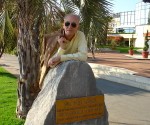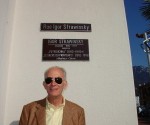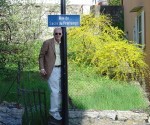The Clearing
All of a sudden the bloom is on Lincoln Center’s newly planted trees, and construction is clearing after what has seemed a lifetime, as construction always does. In the arts world’s current, shameless fund-raising ploy of attaching husband-and-wife donors’ names to every square millimeter of property—stages, box offices, bathrooms, anything (for the time being) that doesn’t move—even a grove of trees adjacent to the David H. Koch Theater backstage entrance is named. Actually, I’m eager to see if these arboreal additions will soften the cold travertine visage that critics have dissed since Philharmonic (now Avery Fisher) Hall opened in 1962. Landscaping is much like clothing in making bare bones look healthy, and presumably the tree donors will help pay for the landscapers.
Look where we are now:
(1) Once again we can enter the subway on 64th Street instead of having to walk up to 66th Street. (Gawd, what an ordeal that has been—nearly as annoying as slogging down to the Chase ATM on 61st Street!)
(2) The Juilliard Bookstore is moving this week from its temporary mobile-home location of the past two years to its permanent (a dangerous word) location, opening on May 10.
(3) The awful clutter around the reflecting pool is gone at last; I’m taking bets now as to how long it will be before it begins to leak again. What a pleasure to see Eero Saarinen’s beautiful Vivian Beaumont Theater again.
(4) And the uptown half of 65th Street between Amsterdam and Broadway is paved.
I have it from good sources that the end of May should bring further clearance in front of Avery Fisher.
Encouraging Kids at the Phil
It’s great to see so many kids at the New York Philharmonic’s “Russian Stravinsky” concerts—students on some group sales program, I figure. And they genuinely seem to be enjoying themselves. Watching a hundred men and women making an exciting sound together in the flesh, rather than on TV or a video, is inspiring. That’s it, guys, get ’em early, when their ears are still open to new sounds (although Stravinsky, dead these 40 years, is by no means new).
So I was pleased to read the Phil’s announcement on Tuesday that Music Director Alan Gilbert would conduct six School Day Concerts next month. His commitment to music in this community is welcome after his predecessor’s lack of involvement. “These concerts, which are designed exclusively for school children in grades 3 through 12, will showcase world-premiere compositions by six New York Philharmonic Very Young Composers, ages 10 and 11, and three composers participating in the Making Score program of the New York Youth Symphony, ages 13 to 16. Also on the program: the score of Stravinsky’s ballet Petrushka.“
Just imagine—being 10 and hearing something you yourself created played by the New York Philharmonic, topped off by Petrushka. Wow! There’s a subscriber for life.
Martin Segal’s Good Works
Speaking of the Beaumont, one of my favorite Lincoln Center events of the year is the annual luncheon to announce the Martin E. Segal Award recipients. The awards were established in the former Lincoln Center Chairman’s name upon his retirement in 1986. Each year two performers nominated by Lincoln Center constituents receive $7,500 “for career advancement and future study.” This year’s engaging young artists were New York City Opera baritone Quinn Kelsey and New York City Ballet principal dancer Daniel Ulbricht.
The astonishingly sprightly, 94-year-old Segal is high on my indebtedness list because he single-handedly scotched Joe Papp’s addlepated idea to convert the Beaumont’s dynamic “thrust” stage into the common proscenium variety. Papp, otherwise a theater visionary, claimed during his brief tenure running the Lincoln Center Theater that Jo Mielziner’s thrust design was unstageable, which has been disproved in my experience—as a press department gofer at the Theater during Jules Irving’s tenure and more recently as a theatergoer, including the long run of South Pacific, which I may have objected to musically and interpretively but not as stagecraft.
Photo: MARTHA SWOPE
That was a credit line I saw often during my three years at the Beaumont, when I was in and out of her 72nd Street studio regularly to pick up photos she had taken of Rep Theater productions. I hadn’t seen Martha for ten years, since we published some of her Sondheim show photos when he was Musical America‘s Composer of the Year for 2000. So when I heard that her photos would be on exhibit for a benefit auction of the Humane Society of New York on April 27th, I hightailed it down to the DVF Studio on West 14th Street.
There she was, hair white, a bit distracted from all the attention, and sporting an elegant-looking cane but otherwise same as ever. And there were several of her wonderful photos—of Lee J. Cobb as Lear, whom I had met in Press Director Susan Bloch’s office during my first interview with her in February 1969; of Tennessee Williams, whom I also met in Susan’s office, at the time of Camino Real a year later; of Arthur Mitchell and Diana Adams rehearsing Agon, with Balanchine and Stravinsky in the background; Balanchine with Maria Tallchief, Suzanne Farrell, Lincoln Kirstein, and his cat Mourka in flight; and shots of several shows I saw over the years, such as A Chorus Line, James Earl Jones and Kevin Conway in Of Mice and Men, Elizabeth Ashley in Cat on a Hot Tin Roof, Angela Lansbury in Sweeney Todd, Blythe Danner in her undies and Keir Dullea in Butterflies Are Free, Meryl Streep in Happy End, and Frank Langella in Dracula.
The rest of the scene was, well, different. Several ladies walked around with dogs, presumably theirs, in their arms; another was stroking a white doggie doll, which I kept looking at, expecting, hoping to see it move. Again and again I saw people I thought I should know, and whose photos I may well have seen in the Times‘s Styles section. But since all the photos weren’t Martha’s, my attention flagged and I was just about to leave when the auction began and I was momentarily trapped. A photo of Marilyn Monroe in peasant garb went for $6,000 and one of Martha’s for around a thousand. And then I left. I wonder how much the photo of a nude woman lying in bed atop her bull mastiff went for?
No Times Rich Obit?
Those who have been awaiting a New York Times obituary of Alan Rich have been given another dash of reality. Allan Kozinn’s evocative obit of Alan appeared online on April 26, and it apparently won’t reach newsprint. Go to www.newyorktimes.com.
P.S. Thursday, April 29: Well, the Times came through at last. Check out Alan’s obit on page 13 of the Business section. He’d act blasé, but, deep down, he’d probably be amazed that they gave him so much room, and with a photo too!


